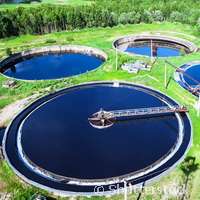Green efficiency boost for water treatment plants

There are more than 65 000 waste water treatment plants in Europe, each providing an essential service to local populations. But by simply installing innovative new equipment, plants could cut energy use by up to 25 percent while increasing nutrient removal by up to 20 percent.
Engineers within the EU-funded project OptimEDAR ('Efficient Management of Small and Medium Wastewater Treatment Plants') are hoping to first demonstrate the feasibility of this new technology, and then to roll it out across Europe.
Leading the team is project coordinator Sergio de Campos from ADASA Sistemas, a Spanish water and environmental monitoring company. The prototype, developed within a national research project, addresses current operational, regulatory and technical weaknesses that are reducing the efficiency of waste water treatment plants across Europe, De Campos explains.
Operationally, a plant is designed to deal with the average waste water flow and composition from the towns or city it serves. But the organic load changes regularly - from day to night, during weekends and between seasons. Some Mediterranean towns see their population increase threefold during summer, for example.
While output is sampled regularly, once a month, in line with EU regulations, the samples are not necessarily an accurate indicator of the plant's entire output. It is in everyone's interests to ensure quality meets the appropriate standards at all times.
At a technical level, all waste water treatment plants have a system to remove the nutrient and organic load. As small and medium-sized plants are not manned at all times, aeration engines are often simply switched on and off at specific times, or according to the readings picked up by a dissolved oxygen sensor.
"But we know from scientific knowledge of the processes inside the tank, and practical experience, that there is a minimum set of parameters that can be measured with non-expensive sensors. With these sensors, OptimEDAR calculates the equivalent organic load, and controls the aeration process according to this 'virtual' information," explains De Campos.
A prototype installed at a plant in Badajoz, Spain, was able to reduce the time that biological blowers operate each day from 14-16 hours to 5-6 hours, while enabling the generation of denitrification and dephosphation cycles. This ensures higher quality output.
De Campos describes these results as "truly spectacular", and is confident that they can be replicated elsewhere - although the energy savings and output improvements will of course vary from plant to plant, according to each plant's current efficiency levels.
Within the OptimEDAR project, the team is conducting case studies in Spain and Romania. The equipment will be installed at six different plants, giving the team the opportunity to assess whether the savings witnessed with the prototype can also be obtained in other environments.
Installing the equipment at different plants is already providing valuable feedback that will help the team revise its specifications so that the end product is suitable - or adjustable - for every small or medium-sized waste water treatment plant in Europe.
Research projects are looking into new treatment processes that would lead to the building of new plants or new process lines in existing plants. This would be a major investment.
What the OptimEDAR project is trying to do, on the other hand, would not require significant funds - the project's objective is simply "to get thousands of existing plants to run properly", says De Campos.
More information: cordis.europa.eu/projects/rcn/108940_en.html
Provided by CORDIS





















